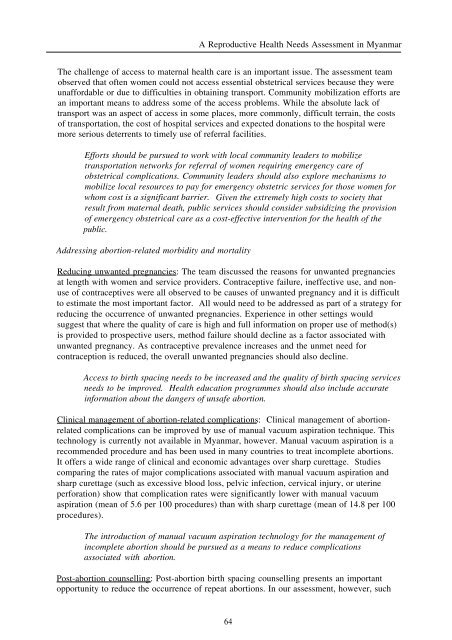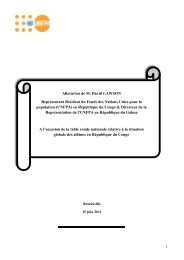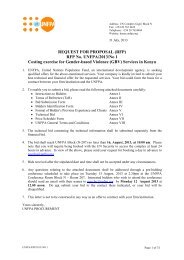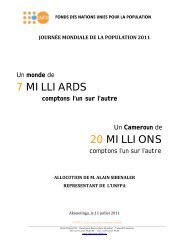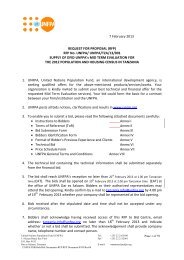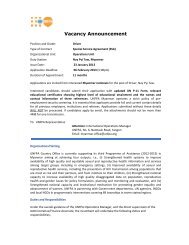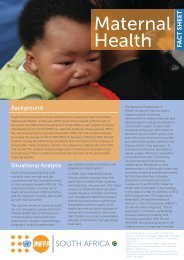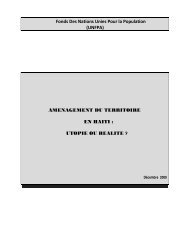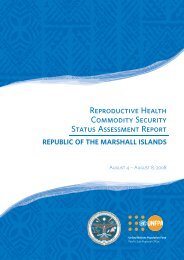A reproductive health needs assessment in Myanmar
A reproductive health needs assessment in Myanmar
A reproductive health needs assessment in Myanmar
Create successful ePaper yourself
Turn your PDF publications into a flip-book with our unique Google optimized e-Paper software.
A Reproductive Health Needs Assessment <strong>in</strong> <strong>Myanmar</strong><br />
The challenge of access to maternal <strong>health</strong> care is an important issue. The <strong>assessment</strong> team<br />
observed that often women could not access essential obstetrical services because they were<br />
unaffordable or due to difficulties <strong>in</strong> obta<strong>in</strong><strong>in</strong>g transport. Community mobilization efforts are<br />
an important means to address some of the access problems. While the absolute lack of<br />
transport was an aspect of access <strong>in</strong> some places, more commonly, difficult terra<strong>in</strong>, the costs<br />
of transportation, the cost of hospital services and expected donations to the hospital were<br />
more serious deterrents to timely use of referral facilities.<br />
Efforts should be pursued to work with local community leaders to mobilize<br />
transportation networks for referral of women requir<strong>in</strong>g emergency care of<br />
obstetrical complications. Community leaders should also explore mechanisms to<br />
mobilize local resources to pay for emergency obstetric services for those women for<br />
whom cost is a significant barrier. Given the extremely high costs to society that<br />
result from maternal death, public services should consider subsidiz<strong>in</strong>g the provision<br />
of emergency obstetrical care as a cost-effective <strong>in</strong>tervention for the <strong>health</strong> of the<br />
public.<br />
Address<strong>in</strong>g abortion-related morbidity and mortality<br />
Reduc<strong>in</strong>g unwanted pregnancies: The team discussed the reasons for unwanted pregnancies<br />
at length with women and service providers. Contraceptive failure, <strong>in</strong>effective use, and nonuse<br />
of contraceptives were all observed to be causes of unwanted pregnancy and it is difficult<br />
to estimate the most important factor. All would need to be addressed as part of a strategy for<br />
reduc<strong>in</strong>g the occurrence of unwanted pregnancies. Experience <strong>in</strong> other sett<strong>in</strong>gs would<br />
suggest that where the quality of care is high and full <strong>in</strong>formation on proper use of method(s)<br />
is provided to prospective users, method failure should decl<strong>in</strong>e as a factor associated with<br />
unwanted pregnancy. As contraceptive prevalence <strong>in</strong>creases and the unmet need for<br />
contraception is reduced, the overall unwanted pregnancies should also decl<strong>in</strong>e.<br />
Access to birth spac<strong>in</strong>g <strong>needs</strong> to be <strong>in</strong>creased and the quality of birth spac<strong>in</strong>g services<br />
<strong>needs</strong> to be improved. Health education programmes should also <strong>in</strong>clude accurate<br />
<strong>in</strong>formation about the dangers of unsafe abortion.<br />
Cl<strong>in</strong>ical management of abortion-related complications: Cl<strong>in</strong>ical management of abortionrelated<br />
complications can be improved by use of manual vacuum aspiration technique. This<br />
technology is currently not available <strong>in</strong> <strong>Myanmar</strong>, however. Manual vacuum aspiration is a<br />
recommended procedure and has been used <strong>in</strong> many countries to treat <strong>in</strong>complete abortions.<br />
It offers a wide range of cl<strong>in</strong>ical and economic advantages over sharp curettage. Studies<br />
compar<strong>in</strong>g the rates of major complications associated with manual vacuum aspiration and<br />
sharp curettage (such as excessive blood loss, pelvic <strong>in</strong>fection, cervical <strong>in</strong>jury, or uter<strong>in</strong>e<br />
perforation) show that complication rates were significantly lower with manual vacuum<br />
aspiration (mean of 5.6 per 100 procedures) than with sharp curettage (mean of 14.8 per 100<br />
procedures).<br />
The <strong>in</strong>troduction of manual vacuum aspiration technology for the management of<br />
<strong>in</strong>complete abortion should be pursued as a means to reduce complications<br />
associated with abortion.<br />
Post-abortion counsell<strong>in</strong>g: Post-abortion birth spac<strong>in</strong>g counsell<strong>in</strong>g presents an important<br />
opportunity to reduce the occurrence of repeat abortions. In our <strong>assessment</strong>, however, such<br />
64


